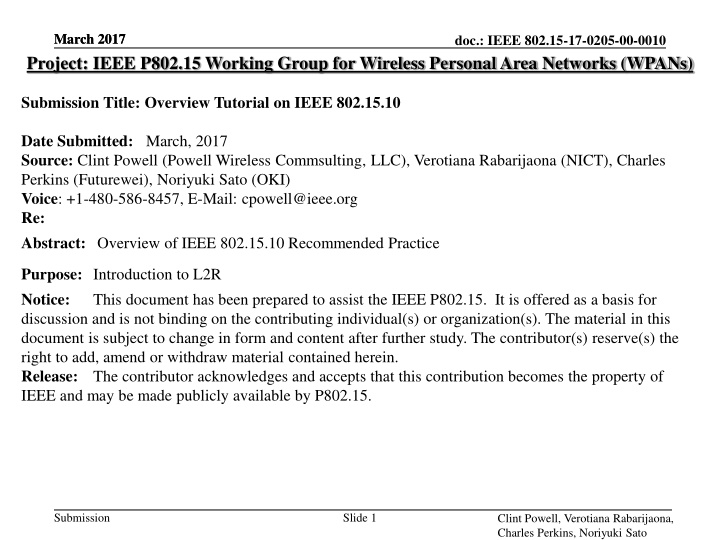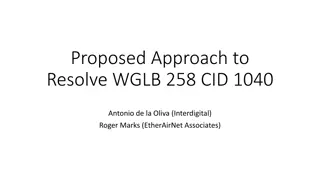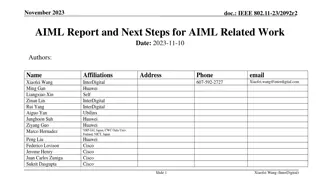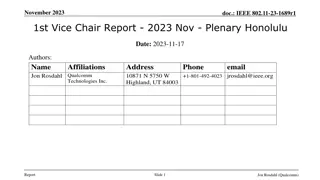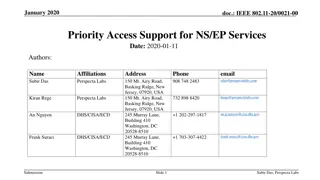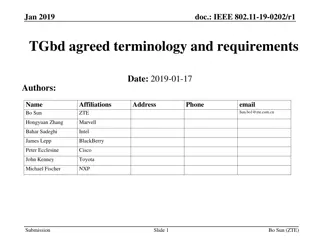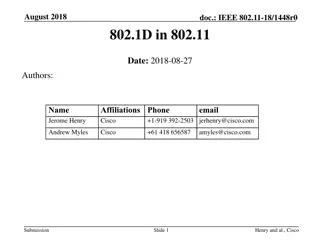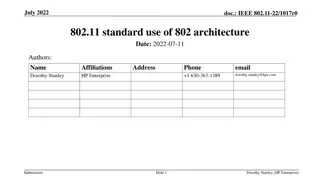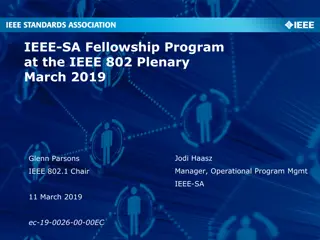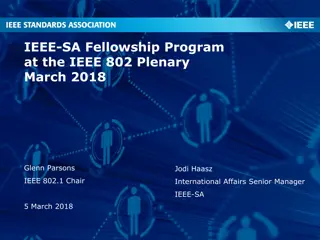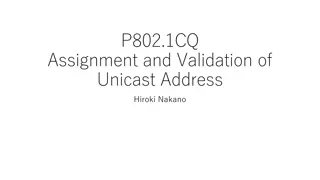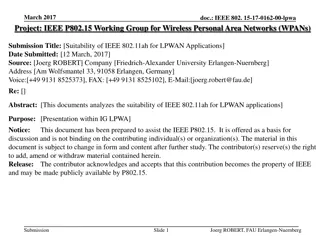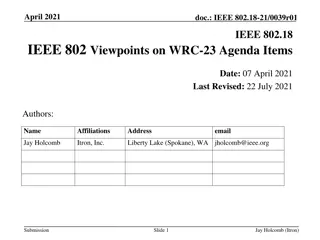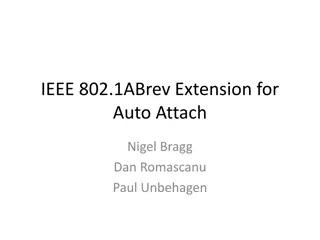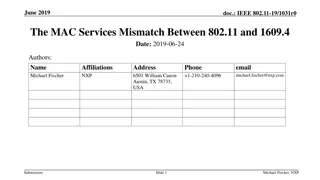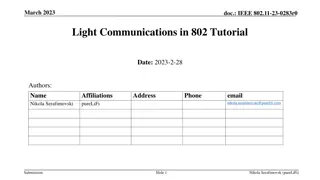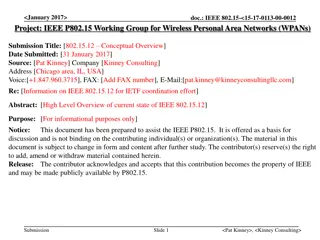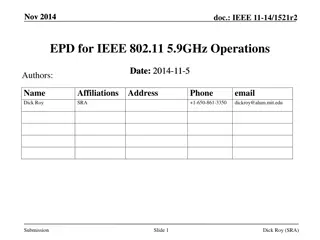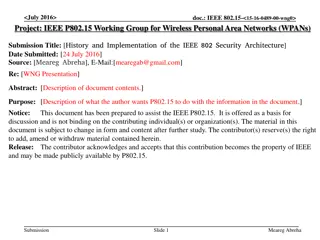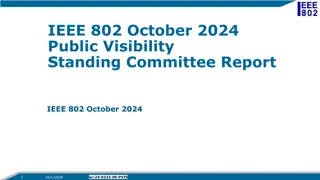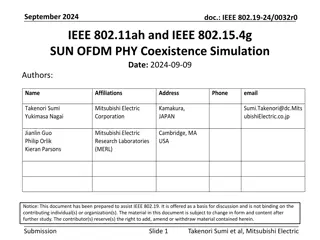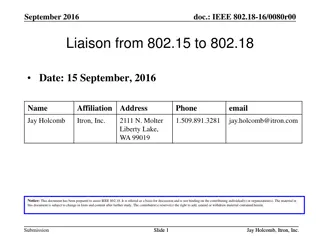Overview of IEEE 802.15.10 Recommended Practice
This document provides an overview of IEEE 802.15.10, focusing on Layer 2 Routing (L2R). It covers system architecture, topologies, routing types, addressing, payload, route metrics, and security features. The purpose is to introduce L2R in the context of Field Area Networks and IoT applications like Smart Energy/Utilities and Smart City control and monitoring.
Download Presentation

Please find below an Image/Link to download the presentation.
The content on the website is provided AS IS for your information and personal use only. It may not be sold, licensed, or shared on other websites without obtaining consent from the author.If you encounter any issues during the download, it is possible that the publisher has removed the file from their server.
You are allowed to download the files provided on this website for personal or commercial use, subject to the condition that they are used lawfully. All files are the property of their respective owners.
The content on the website is provided AS IS for your information and personal use only. It may not be sold, licensed, or shared on other websites without obtaining consent from the author.
E N D
Presentation Transcript
March 2017 Project: IEEE P802.15 Working Group for Wireless Personal Area Networks (WPANs) March 2017 doc.: IEEE 802.15-17-0205-00-0010 Submission Title:Overview Tutorial on IEEE 802.15.10 Date Submitted: March, 2017 Source: Clint Powell (Powell Wireless Commsulting, LLC), Verotiana Rabarijaona (NICT), Charles Perkins (Futurewei), Noriyuki Sato (OKI) Voice: +1-480-586-8457, E-Mail: cpowell@ieee.org Re: Abstract: Overview of IEEE 802.15.10 Recommended Practice Purpose: Introduction to L2R Notice: This document has been prepared to assist the IEEE P802.15. It is offered as a basis for discussion and is not binding on the contributing individual(s) or organization(s). The material in this document is subject to change in form and content after further study. The contributor(s) reserve(s) the right to add, amend or withdraw material contained herein. Release: The contributor acknowledges and accepts that this contribution becomes the property of IEEE and may be made publicly available by P802.15. Submission Slide 1 Clint Powell, Verotiana Rabarijaona, Charles Perkins, Noriyuki Sato
March 2017 doc.: IEEE 802.15-17-0205-00-0010 Outline Overview System Architecture Topologies IE's Overview/Use Routing Types Supported Addressing Supported Payload & Address at each Hop Route Metrics Security Features Submission Slide 2 Clint Powell, Verotiana Rabarijaona, Charles Perkins, Noriyuki Sato
March 2017 doc.: IEEE 802.15-17-0205-00-0010 Layer 2 Routing (L2R) Overview Motivation Growing use of 802.15 in large mesh network applications such as Utility and more generally in Field Area Networks Need to address general requirements for L2 routing in Field Area Networks utilizing newer 15.4g and 15.4e amendments Support and use in higher layer protocols the Internet of Things Applications Smart Energy/Utilities (Smart Metering, FANs ) Smart City (Street Lighting/Parking/Metering ) Control and Monitoring (Smart Home, etc.) Automation Submission Slide 3 Clint Powell, Verotiana Rabarijaona, Charles Perkins, Noriyuki Sato
March 2017 doc.: IEEE 802.15-17-0205-00-0010 Layer 2 Routing (L2R) Overview 802.15 TG10 - L2R Purpose Defines protocols that route packets in a dynamically changing (order of a minute) 802.15.4 network Extends the area of coverage as the number of nodes increase Supports Data Concatenation Supports small, medium and large scale networks Anticipated Publication Date April 2017 Submission Slide 4 Clint Powell, Verotiana Rabarijaona, Charles Perkins, Noriyuki Sato
March 2017 doc.: IEEE 802.15-17-0205-00-0010 System architecture L2R management (start, join...) L2R Data PAN management (start, association...) MAC Data PHY settings (frame size, channel...) PHY Data LME: (sub)layer management entity MLME: MAC LME SAP: service access point MCPS: MAC common part sublayer L2RLME: Layer 2 Routing LME PLME: PHY LME PD: PHY layer data Submission Slide 5 Clint Powell, Verotiana Rabarijaona, Charles Perkins, Noriyuki Sato
March 2017 doc.: IEEE 802.15-17-0205-00-0010 Topologies Multiple services in one mesh * The definition of services are out of scope Same service provided in different meshes Optional direct connection to the PAN coordinator through an external network (3G, 4G, WiMAX...) Used for short address assignment, credential verification... Support for multiple meshes in one PAN Submission Slide 6 Clint Powell, Verotiana Rabarijaona, Charles Perkins, Noriyuki Sato
March 2017 doc.: IEEE 802.15-17-0205-00-0010 Topologies Multi-PAN Operation - For TV White space cluster tree PAN (TMCTP - IEEE 802.15.4m) - Operates with EUI-64 addresses Single mesh rooted at the super PAN coordinator Submission Slide 7 Clint Powell, Verotiana Rabarijaona, Charles Perkins, Noriyuki Sato
March 2017 doc.: IEEE 802.15-17-0205-00-0010 Topologies Small scale PAN - Single mesh in the PAN - PAN coordinator and mesh root implemented in the same device - Uses short nested IE for downstream route establishment and routing Submission Slide 8 Clint Powell, Verotiana Rabarijaona, Charles Perkins, Noriyuki Sato
March 2017 doc.: IEEE 802.15-17-0205-00-0010 IE Overview IEEE 802.15.10 uses the frame formats available in IEEE 802.15.4 L2R functions are enabled with nested IEs Each nested IE enables one L2R operation Covered in IEEE 802.15.4 The MLME IE is used in an enhanced beacon (EB), enhanced beacon request (EBR) or a data frame Submission Slide 9 Clint Powell, Verotiana Rabarijaona, Charles Perkins, Noriyuki Sato
March 2017 doc.: IEEE 802.15-17-0205-00-0010 IE s & Uses IE name Description L2R discovery (L2R-D) IE Used for L2R mesh management (discovery, join, start...) Topology construction (TC) IE Neighbor link metric (NLM) IE Short route announcement (SRA) IE Used for establishing downstream routes (unicast and multicast) Route announcement (RA) IE Peer-to-peer request (P2P-RQ) IE Used for establishing P2P routes between two devices Peer-to-peer reply (P2P-RQ) IE Short L2R routing (SLR) IE Used for data routing L2R Routing IE Address assignment request (AA-RQ) IE Address assignment reply (AA-RP) IE Used for managing short address assignment Address release (A-RLS) IE Data concatenation (DCat) IE Used to when a data frame is the concatenation of several data frames Submission Slide 10 Clint Powell, Verotiana Rabarijaona, Charles Perkins, Noriyuki Sato
March 2017 doc.: IEEE 802.15-17-0205-00-0010 Routing Types Supported - Unicast Upstream: L2R device to the mesh root Enabled as soon as a device has joined the mesh Example use cases: Infrastructure monitoring Traffic monitoring Smart meter reading HVAC monitoring Environment monitoring Agriculture monitoring Asset tracking Parking monitoring Submission Slide 11 Clint Powell, Verotiana Rabarijaona, Charles Perkins, Noriyuki Sato
March 2017 doc.: IEEE 802.15-17-0205-00-0010 Routing Types Supported - Unicast Downstream: mesh root to L2R device Requires route establishment with a (short) route announcement IE ((S)RA IE) Example use cases: HVAC control Traffic messaging Traffic signal control Irrigation Submission Slide 12 Clint Powell, Verotiana Rabarijaona, Charles Perkins, Noriyuki Sato
March 2017 doc.: IEEE 802.15-17-0205-00-0010 Routing Types Supported - Unicast Peer-to-peer: L2R device to L2R device Combination of US and DS routing or Routing on the path established with an exchange of P2P request (P2P-RQ) and P2P reply (P2P-RP) IEs Avoid root node congestion Minimize #hops, energy consumption Minimize end-to-end delay Most traffic does not traverse the root Example use cases: Factory automation Building automation Combination of US/DS routing Routing on established P2P path Submission Slide 13 Clint Powell, Verotiana Rabarijaona, Charles Perkins, Noriyuki Sato
March 2017 doc.: IEEE 802.15-17-0205-00-0010 Routing Types Supported Multicast L2R device to group of L2R devices based on function (temperature sensor, light...), location (floor, building, district...), or other criteria Uses flooding with higher layer filtering, or routing on multicast paths established using Multicast Subscription field of the route announcement IE (RA IE) ACK may not be supported Example use cases: Street lighting Building, factory, city energy management systems (BEMS, FEMS, CEMS) Sprinkler control Entrance/Exit control Submission Slide 14 Clint Powell, Verotiana Rabarijaona, Charles Perkins, Noriyuki Sato
March 2017 doc.: IEEE 802.15-17-0205-00-0010 Routing Types Supported Broadcast Frames sent to all nodes in the mesh. No route establishment required. An L2R device forwards a frame if it has at least one neighbor other than the L2R device from which the frame was received Useful for topology building, neighborhood discovery, and route establishment Care must be used since no acknowledgement R Destinations C D E Example use cases: Emergency notification Outage notification Measurement/reading/sensing request Ping after disaster I H G Broadcast communication Submission Slide 15 Clint Powell, Verotiana Rabarijaona, Charles Perkins, Noriyuki Sato
March 2017 doc.: IEEE 802.15-17-0205-00-0010 Routing Types Supported - Options Source routing (DS and P2P) Octets: ... ... 1 0/Variable Number of Intermediate Addresses Intermediate Address List (S)RA IE, SLR IE, L2R Routing IE, P2P RQ/RP IEs content Hop-by-hop retransmission Enabled with the L2R Retransmission flag in the L2R Routing IE Requires MAC ACK Retransmission through a different neighbor * Not supported with source routing Failed transmission Submission Slide 16 Clint Powell, Verotiana Rabarijaona, Charles Perkins, Noriyuki Sato
March 2017 doc.: IEEE 802.15-17-0205-00-0010 Routing Types Supported - Options End-to-end acknowledgment Enabled with the E2E AR flag in the L2R Routing IE Uses the E2E-ACK IE Submission Slide 17 Clint Powell, Verotiana Rabarijaona, Charles Perkins, Noriyuki Sato
March 2017 doc.: IEEE 802.15-17-0205-00-0010 Routing Types Supported Options Sibling routing When enabled, allows routing through a neighbor of the same depth Increases robustness Requires resources for loop avoidance Submission Slide 18 Clint Powell, Verotiana Rabarijaona, Charles Perkins, Noriyuki Sato
March 2017 doc.: IEEE 802.15-17-0205-00-0010 Addressing Supported All devices in the mesh must use the same address length (either 16-bit or 64-bit) Unicast, multicast, and broadcast are supported with either address length PAN coordinator manages address assignment upon request, with signaling mediated by the mesh root Uses the following short nested IEs for short address assignment: AA-RQ IE AA-RP IE A-RLS IE Pre-assigned addresses are O.K. Submission Slide 19 Clint Powell, Verotiana Rabarijaona, Charles Perkins, Noriyuki Sato
March 2017 doc.: IEEE 802.15-17-0205-00-0010 Example for AA-RQ and AA-RP IEs Node I requests a new address using AA-RQ Root gets address from PAN coordinator, sends back to I with AA-RP Submission Slide 20 Clint Powell, Verotiana Rabarijaona, Charles Perkins, Noriyuki Sato
March 2017 doc.: IEEE 802.15-17-0205-00-0010 Payload & Address at each Hop Time To Live (TTL) is decreased Each intermediate router sets the transmit address to its own MAC address. Each intermediate router sets the next hop address appropriately depending on whether US, DS, or P2P routing is in use, possibly modified by sibling routing. 802.15.4 enables per-hop acknowledgement to be requested; 802.15.10 offers in addition end-to-end acknowledgement. Payload can be increased by data concatenation, and IEs manipulated as shown on the next slide; otherwise the payload remains unchanged. Submission Slide 21 Clint Powell, Verotiana Rabarijaona, Charles Perkins, Noriyuki Sato
March 2017 doc.: IEEE 802.15-17-0205-00-0010 Data Concatenation (DCat) E transmits concatenation of ((A | B) | D) | E all to same destination Submission Slide 22 Clint Powell, Verotiana Rabarijaona, Charles Perkins, Noriyuki Sato
March 2017 doc.: IEEE 802.15-17-0205-00-0010 Route Metrics Description # hops source --> destination Received Signal Weakness (RSW) Estimated # of retransmissions Expected airtime time to successfully send a frame Vendor specific PQM defined by the implementer. Metric ID Metric type name 0 Hop count 1 RSW 2 ETX 3 15 # of octets 1 2 2 4 There are four predefined metrics: Hop Count, RSW, ETX, and Expected Airtime. RSW is related to signal strength All predefined metrics are integer and additive, monotonically increasing metrics. Submission Slide 23 Clint Powell, Verotiana Rabarijaona, Charles Perkins, Noriyuki Sato
March 2017 doc.: IEEE 802.15-17-0205-00-0010 Security Features Security Setting PIBs Discovery L2R-D IEs are exchanged in an EBR and an EB without security Indicates key exchange method - Non secure, Out-of-band, KMP Key setting Attributes of L2IB are set by higher layer or out-of-band mechanism Key exchange can be done by IEEE802.15.9. Related L2IB L2R Unicast Security attributes A key is managed by MAC layer. Key usage is managed by L2R (Key ID mode, Key source, Key index) Individual key usage can be set per neighbor (IEEE802.15.4 supports a link key) Different key usage for general unicast, RA IE and AA IE specific. L2R Broadcast Security attributes Different key usages can be set for general BC, TC IE and NLM IE. Submission Slide 24 Clint Powell, Verotiana Rabarijaona, Charles Perkins, Noriyuki Sato
March 2017 doc.: IEEE 802.15-17-0205-00-0010 Example bootstrap with IEEE802.15.9 Submission Slide 25 Clint Powell, Verotiana Rabarijaona, Charles Perkins, Noriyuki Sato
March 2017 doc.: IEEE 802.15-17-0205-00-0010 Questions? Submission Slide 26 Clint Powell, Verotiana Rabarijaona, Charles Perkins, Noriyuki Sato
